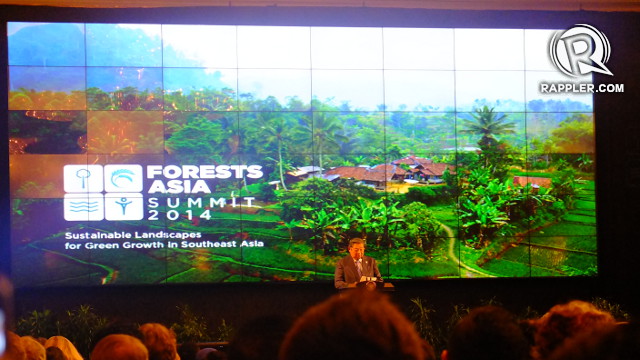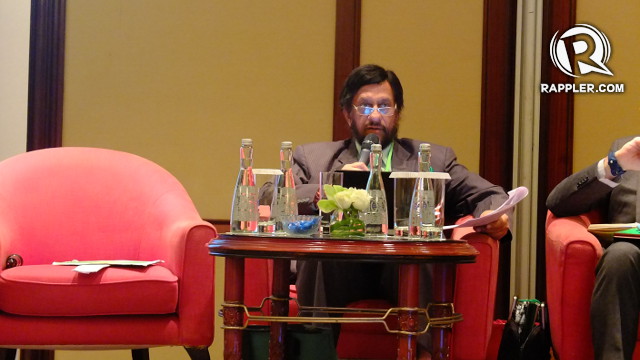SUMMARY
This is AI generated summarization, which may have errors. For context, always refer to the full article.
JAKARTA, Indonesia – World-renowned scientists, environmentalists, private sector leaders, and government officials committed to protect Southeast Asian forests in a summit held in Jakarta, Indonesia.
The Forests Asia Summit 2014, held from May 5 to 6, gathered experts and advocates to talk about the future of forests in the region. Southeast Asian countries have among the fastest growing economies in the world and hold much of the world’s biodiversity and remaining forest cover.
“The world is at a turning point. Forests in Southeast Asia are a critical part of the future. Forests contribute strongly to development priorities such as food security, poverty, sustainable land use and climate change,” said Peter Holmgren, director general of the Center for International Forestry Research (CIFOR), during the event’s opening ceremony.
Southeast Asia has lost 13% of its forests in the last 20 years – equivalent to around 332,000 square kilometers of forest land, an area roughly the size of Vietnam.
The severe deforestation has been driven mainly by demand for timber, wood for fuel and expansion of land for agricultural, industrial or commercial use, according to the ASEAN Center for Biodiversity.
Forests vs food?
The forum hoped to raise awareness about issues not often linked to forests. Food security is one of them. By 2030, Southeast Asia will have 84 million more people, the equivalent of Vietnam’s current population but without the extra land.
Recent studies show forests help make nutritious food more accessible to rural households. Certain communities in Indonesia, for instance, get 80% of their protein from bushmeat or meat from wild animals found in the forest.
Berries, mushrooms, medicinal plants and fruits are other forest products that help sustain some of the region’s poorest communities, those often not reached by government services.
In parts of rural Indonesia, 77% of the income of forest-dwelling households comes directly from nature, said economist Pavan Sukhdev, a United Nations Environment Programme Goodwill ambassador.
But the economic benefits of forests are often not included in computations for national growth domestic product (GDP).
“This is what I call the GDP of the poor. We need a new economic indicator that considers the invisible economics of forests,” said Sukhdev during one of the summit’s panel discussions.
Scientists also tackled the crucial debate on whether the protection of forests comes at the cost of producing food. One of the biggest drivers of deforestation is expansion of agricultural land needed to produce crops to feed the world’s growing population.
But Chinese scientist Xie Chen showed how the Chinese government’s program to reforest existing agricultural land did not pull down the country’s overall agricultural production. Government subsidies helped sustain the 32 million farming households that allowed reforestation on their crop lands.
In fact, forests may even help make agricultural lands more productive by providing clean running water for irrigation and making soil healthier and more fertile, Chen told Rappler.
Forests and climate change
The crucial role of forests in curbing climate change was another major topic discussed during the summit.
Deforestation is one of the 3 top drivers of greenhouse gas emissions in the world, along with the transportation sector and fossil fuel industry. This is because forests store a lot of carbon, an element that is released into the atmosphere as carbon dioxide, the most common greenhouse gas.
When forests are cut down for timber or to clear more land for crops, the stored carbon dioxide is released only to persist in the atmosphere. Carbon dioxide traps heat from the sun causing the Earth to warm up.
For this reason, Dr Rajendra Pachauri, chairman of the UN Intergovernmental Panel on Climate Change (IPCC) called for the reduction of deforestation and increase in reforestation.
Forests help capture carbon dioxide from the atmosphere, thereby reducing the emissions that stay in the air and drive warming.
This unique role of forests has motivated the creation of Reducing Emissions from Deforestation and Degradation Plus (REDD+), a mechanism introduced by the United Nations that allows countries and companies to pay for the conservation of forests.
Using special tools, the amount of carbon stored in a particular forest is measured and given a financial value called carbon credit. Countries or companies can earn that carbon credit by providing the financial capital to protect the forest.
But many roadblocks are in the way of large-scale implementation of REDD+. The market for carbon credits must still be developed and stimulated. Unsecure land tenure of forest-dwelling communities also poses questions on who owns forests and thus stands to benefit from REDD+.
As a whole Southeast Asian forests continue to be threatened by illegal logging and unsustainable land-use planning. The economic growth of ASEAN nations continues to put pressure on forests. But Dr Pachauri cautions against economic growth that does not consider forests and the people who depend on them.
“The whole point of economic growth is the welfare of the people. If the pattern of growth we are pursuing poses grave externalities, we need to redefine the path of growth and development.” – Rappler.com
Add a comment
How does this make you feel?


There are no comments yet. Add your comment to start the conversation.